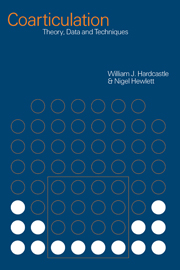Book contents
- Frontmatter
- Contents
- List of figures
- List of tables
- List of contributors
- Acknowledgments
- Introduction
- Part I Theories and models
- Part II Research results: components of the motor system for speech
- Part III Wider perspectives
- Part IV Instrumental techniques
- 10 Palatography
- 11 Imaging techniques
- 12 Electromagnetic articulography
- 13 Electromyography
- 14 Transducers for investigating velopharyngeal function
- 15 Techniques for investigating laryngeal articulation
- 16 Acoustic analysis
- References
- Index
13 - Electromyography
Published online by Cambridge University Press: 22 September 2009
- Frontmatter
- Contents
- List of figures
- List of tables
- List of contributors
- Acknowledgments
- Introduction
- Part I Theories and models
- Part II Research results: components of the motor system for speech
- Part III Wider perspectives
- Part IV Instrumental techniques
- 10 Palatography
- 11 Imaging techniques
- 12 Electromagnetic articulography
- 13 Electromyography
- 14 Transducers for investigating velopharyngeal function
- 15 Techniques for investigating laryngeal articulation
- 16 Acoustic analysis
- References
- Index
Summary
Introduction
Most of the techniques discussed in these chapters are designed to record, directly or indirectly, movements of the various respiratory, laryngeal or supralaryngeal (articulatory) structures involved in the production of speech. However, there is considerable interest also amongst speech scientists in the underlying neuromuscular control mechanisms that make such movements possible, the patterns of contraction and relaxation in the various muscles and muscle groups and the electrical discharges that accompany such contractions. It is these changes in electrical activity within muscles which the technique of electromyography (EMG) aims to record. Although the simple detection of electrical changes in muscles as they increase in tension is a relatively straightforward process, the interpretation of the records of such changes in terms of the functions of particular muscles and the resultant movements of speech organs is extremely complex and far from straightforward. This brief outline of EMG techniques discusses the various components of the EMG system (the types of electrodes, amplification, recording apparatus), signal processing techniques used in data reduction, the type of research that can be carried out with the technique into aspects of both normal and pathological speech and the general problems associated with the use of EMG for speech research purposes. Before discussing the technique itself, however, it is useful to outline the main neuromuscular features of muscle activity as background for interpreting the electromyogram.
- Type
- Chapter
- Information
- CoarticulationTheory, Data and Techniques, pp. 270 - 283Publisher: Cambridge University PressPrint publication year: 1999

